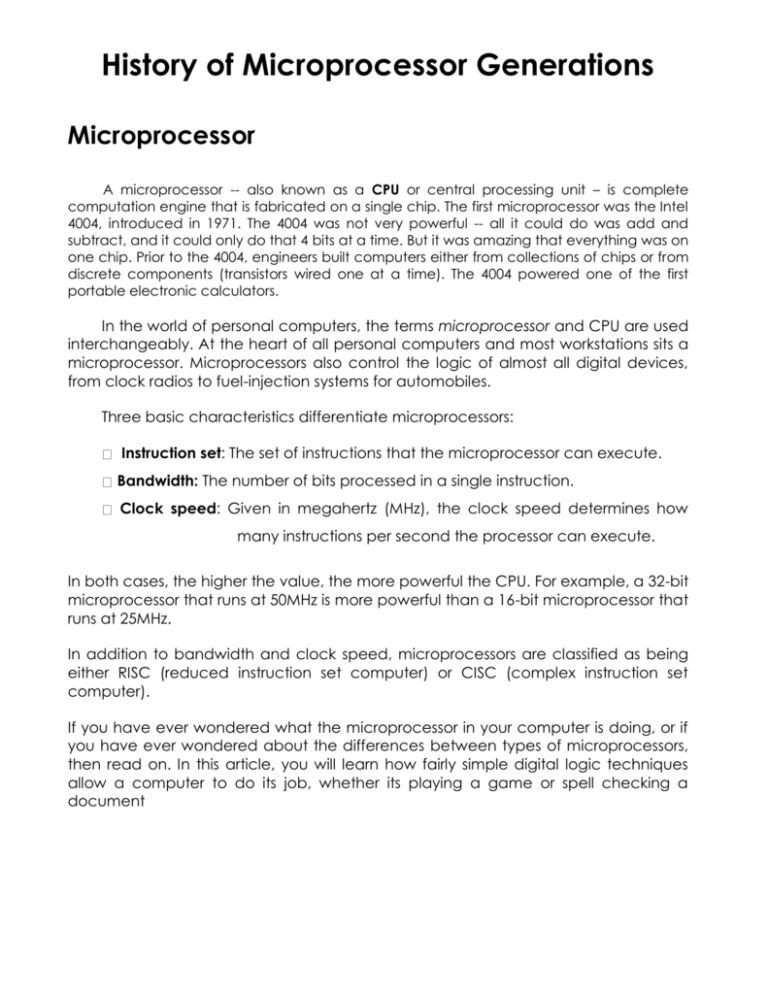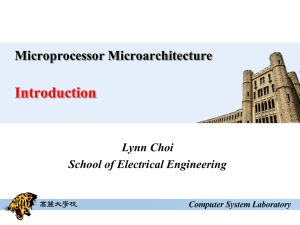History of Microprocessors: Generations, Intel CPUs
advertisement

History of Microprocessor Generations Microprocessor A microprocessor -- also known as a CPU or central processing unit – is complete computation engine that is fabricated on a single chip. The first microprocessor was the Intel 4004, introduced in 1971. The 4004 was not very powerful -- all it could do was add and subtract, and it could only do that 4 bits at a time. But it was amazing that everything was on one chip. Prior to the 4004, engineers built computers either from collections of chips or from discrete components (transistors wired one at a time). The 4004 powered one of the first portable electronic calculators. In the world of personal computers, the terms microprocessor and CPU are used interchangeably. At the heart of all personal computers and most workstations sits a microprocessor. Microprocessors also control the logic of almost all digital devices, from clock radios to fuel-injection systems for automobiles. Three basic characteristics differentiate microprocessors: Instruction set: The set of instructions that the microprocessor can execute. Bandwidth: The number of bits processed in a single instruction. Clock speed: Given in megahertz (MHz), the clock speed determines how many instructions per second the processor can execute. In both cases, the higher the value, the more powerful the CPU. For example, a 32-bit microprocessor that runs at 50MHz is more powerful than a 16-bit microprocessor that runs at 25MHz. In addition to bandwidth and clock speed, microprocessors are classified as being either RISC (reduced instruction set computer) or CISC (complex instruction set computer). If you have ever wondered what the microprocessor in your computer is doing, or if you have ever wondered about the differences between types of microprocessors, then read on. In this article, you will learn how fairly simple digital logic techniques allow a computer to do its job, whether its playing a game or spell checking a document Concise Timeline of Microprocessors: Abacus (3000 B.C): was the first computer in the history of the computing machines. 1st Generation Computers (1946-1952): fastest machine of the time. 2nd Generation Computers (1956): transistor was first time used in it. 3rd Generation Computers: integrated (circuit) chips. 4th Generation Computers: Highly sophisticated technology required. Personal Computers (1975): MITS ALTAIR first computer with TV. 1995: Pentium-Pro Microprocessor Windows 95 OS In 1997 Intel announces Multimedia capabilities (PII). 1998 Windows 1998 OS supported processors. This was much user friendly. Revolution in the Fabrication of Microprocessors After launching of windows 98(OS) there started a race of higher performance computing machines. Microprocessors started to reform in small and small size but the speed was increasing by and by and this race is still going on and now its momentum is much faster then ever before. There is a detailed history of processors which have been produced since year 2000 to till now. * There are some big or major companies which are producing microprocessors and running side by side in that race but three companies are most famous for this work 1st is Intel and 2nd is IBM and 3rd is AMD. Intel In these companies the most prominent company is Intel. It is just because of the reliability and batter results of Intel processors. Here is a report on Intel processors. If we start counting from year2000 their first processor was based on "Celeron" technology. Intel Celeron: Introduced in April 1998, the first Celeron branded CPU was based on the Pentium II branded core. Subsequent Celeron branded CPUs were based on the Pentium III, Pentium 4, Pentium M, and Core 2 Duo branded processors. The Celeron brand refers to a range of Intel's x86 CPUs for budget/value personal computers. Considered Intel's "economic" processor, the Celeron branded processors have complemented Intel's higher-performance (and more expensive) brands. Intel has given the brand the motto, "delivering great quality at an exceptional value." Celeron processors can run all IA-32 computer programs, but their performance is somewhat lower when compared to similar, but higher priced, Intel CPU brands. For example, the Celeron brand will often have less cache memory, or have advanced features purposely disabled. These missing features have had a variable impact on performance. In some cases, the effect was significant and in other cases the differences were relatively minor. Many of the Celeron designs have achieved a very high "bang to the buck," while at other times, the performance difference has been noticeable. Here is a brief history of Intel Celeron Processors from the year 2000 up to now. Year of Production Proceedings Year 2000 January 4 Intel® Celeron® Processor 533 MHz February 14 Mobile Intel® Celeron® Processor 500 MHz, 450 MHz June 19 Low Voltage Mobile Intel® Celeron® Processor 500 MHz Year 2001 January 3 Intel® Celeron® Processor 800 MHz October 2 Intel® Celeron® Processor 1.20 GHz Year 2002 January 3 Intel® Celeron® Processor 1.30 GHz November 20 Intel® Celeron Processor 2.20 GHz, 2.10 GHz Year 2003 Year 2004-07 January 14 Mobile Intel® Celeron® Processor 2 GHz Low Voltage Mobile Intel® Celeron® Processor 866 MHz November 12 Mobile Intel® Celeron® Processor 2.50 GHz Ultra Low Voltage Mobile Intel® Celeron® Processor 800 MHz January 4, 2004 Intel® Celeron® M Processor 320 and 310 1.3 GHz 1.2 GHz July 20, 2004 Intel® Celeron® M processor Ultra-Low Voltage 353 900 MHz March Intel® Celeron® M Processor 430-450 1.73-2.0GHz November 23 Intel® Celeron® D Processor 345 3.06 GHz * No Celeron Processor was released in 2007 Year 2008 January 2008 Celeron Core 2 Duo (Allendale) Pentium: The Pentium brand refers to Intel's single-core x86 microprocessor based on the P5 fifth-generation micro architecture considered here as such only. The name 'Pentium' was derived from the Greek penta, meaning 'five', and the Latin ending ium. Introduced on March 22, 1993 the Pentium succeeded the Intel 486, which number "4" signified the fourth-generation micro architecture. In 1996, the original Pentium was succeeded by the Pentium MMX branded CPUs still based on the P5 fifthgeneration micro architecture. Starting in 1995, Intel (inconsistently) used the "Pentium" registered trademark in the names of families of post-fifth-generations of x86 processors branded as the Pentium Pro, Pentium II, Pentium III, Pentium 4 and Pentium D (see Pentium (brand)). Although they shared the x86 instruction set with the original Pentium (and its predecessors), their micro architectures were radically different from the P5 micro architecture of CPUs branded just as the "Pentium" and "Pentium MMX". * Vinod Dham is often referred to as the father of the Intel Pentium processor. Here is a brief History of Intel Pentium Processors Year of Production Proceedings Year 2000 March 20 Intel® Pentium® III Processor 866 MHz, 850 MHz March 8 Intel® Pentium® III Processor 1 GHz Year 2001 November 20 Intel® Pentium® 4 Processor 1.50 GHz, 1.40 GHz April 23 Pentium® 4 Processor1.7 July 2 Pentium® 4 Processor 1.80 GHz, 1.60 GHz August 27 Intel® Pentium® 4 Processor 2 GHz, 1.90 GHz0 GHz Year 2002 January 7 Intel® Pentium® 4 Processor 2.20 GHz, 2 GHz January 8 Intel® Pentium® III Processor for servers 1.40 GHz April 2, 2002 Intel® Pentium® 4 Processor2.40 GHz, 2.20 GHz January 21 Ultra Low Voltage Mobile Pentium® III Processor-M 750 MHz Low Voltage Mobile Pentium® III Processor-M 866 MHz, 850 MHz November 14, 2002 Intel® Pentium® 4 Processor 3.06 GHz with Hyper-Threading Technology Year 2003 Mobile Intel® Pentium® 4 Processor-M 2.40 GHz (400 MHz PSB) May 21, Intel® Pentium® 4 Processor with Hyper-Threading Technology 2.80C GHz, 2.60C GHz, 2.40C GHz November 3, Intel® Pentium® 4 Processor Extreme Edition 3.20 GHz Year 2004 February 2, 2004 Intel® Pentium® 4 Processor (90nm) 3.40 GHz, 3.20 GHz, 3.0 GHz, 2.80 GHz Intel® Pentium® 4 Processor Extreme Edition (0.13 micron) 3.40 GHz April 7, 2004 Ultra Low Voltage Intel® Pentium® M Processor 1.10 GHz, 1.30Ghz November 15, 2004 Intel® Pentium® 4 Processor Extreme Edition supporting HT Technology 3.46 GHz Year 2005-06 Intel® Pentium® 4 Processor Extreme Edition supporting HT Technology 3.80 GHz (570) April, 2005 Intel® Pentium® Processor Extreme Edition 840 3.20 GHz * No Pentium Processor designed in 2006. 2007 & 2008 Intel® Pentium™ Processor Extreme Edition 955 3.46 GHz Intel® Pentium™ Processor Extreme Edition 965 3.73 GHz *No Pentium processor designed yet in 2008 Production of Pentium processors decreased in these years due to modern technology Xeon: The Xeon brand refers to many families of Intel's x86 multiprocessing CPUs – for dual-processor (DP) and multi-processor (MP) configuration on a single motherboard targeted at non-consumer markets of server and workstation computers, and also at blade servers and embedded systems. The Xeon brand has been maintained over several generations of x86 and x86-64 processors. Older models added the Xeon moniker to the end of the name of their corresponding desktop processor, but more recent models used the name Xeon on its own. The Xeon CPUs generally have more cache than their desktop counterparts in addition to multiprocessing capabilities. Intel's (non-x86) IA-64 processors are called Itanium, not Xeon. Here is a brief history of Intel Xeon Processors Year of Production Proceedings Year 2000 & 2001 January 12 Intel® Pentium® III Xeon™ Processor 800 MHz September 25, 2001 Intel® Xeon™ Processor 2 GHz May 24 Intel® Pentium® III Xeon™ Processor 933 MHz Year 2002-04 January 9, 2002 Intel® Xeon™ Processor 2.20 GHz March 12, 2002 Intel® Xeon™ Processor MP1.60GHz March 10, 2003 Intel® Xeon™ Processor 3 GHz (400 MHz system bus) November 18 Intel® Xeon™ Processor 2.80 GHz, October 6, 2003 Intel® Xeon™ Processor 3.20 GHz March 2, 2004 Intel® Xeon™ Processor MP 3 GHz (4 MB L3 cache) Year 2005-08 March, 2005 Intel® Xeon Processor MP 2.666 - 3.666 GHz October, 2005 Dual Core Intel® Xeon Processor 2.8 GHz August, 2006 Dual-Core Intel® Xeon™ 7140M 3.33-3.40 GHz Itanium Itanium is the brand name for 64-bit Intel microprocessors that implement the Intel Itanium architecture (formerly called IA-64). Intel has released two processor families using the brand: the original Itanium and the Itanium 2. Starting November 1, 2007, new members of the second family are again called Itanium. The processors are marketed for use in enterprise servers and high-performance computing systems. The architecture originated at Hewlett-Packard (HP) and was later developed by HP and Intel together. Itanium's architecture differs dramatically from the x86 architectures (and the x8664 extensions) used in other Intel processors. The architecture is based on explicit instruction-level parallelism, with the compiler making the decisions about which instructions to execute in parallel. This approach allows the processor to execute up to six instructions per clock cycle. By contrast with other superscalar architectures, Itanium does not have elaborate hardware to keep track of instruction dependencies during parallel execution - the compiler must keep track of these at build time instead. After a protracted development process, the first Itanium was released in 2001, and more powerful Itanium processors have been released periodically. HP produces most Itanium-based systems, but several other manufacturers have also developed systems based on Itanium. As of 2007, Itanium is the fourth-most deployed microprocessor architecture for enterprise-class systems. Itanium has now become a leading microprocessor. Itanium has been used with Dell™ as well as with HP systems. Intanium 1 is being upgraded to Itanium 2 by the Inter Corporation. Itanium 2 will be the giant of micro-processing as it can execute billions of instruction in a second causing the computing to turn a revolutionary change. Here is a brief history of Itanium processors Year of Production Proceedings Year 2001-06 May 29, 2001 Intel® Itanium™ Processor 800 MHz, 733 MHz July 8, 2002 Intel® Itanium® 2 Processor 1 GHz, 900 MHz September 8, 2003 Intel® Itanium™ 2 Processor 1.40 GHz (1.5 MB L3 cache) Low Voltage Intel® Itanium™ 2 Processor 1 GHz (1.5 MB L3 cache) June 30, 2003 Intel® Itanium™ 2 Processor 1.50 GHz April 13, 2004 Intel® Itanium® 2 Processor (with 3 MB L3 cache) 1.60 GHz Oct. 20, 2004 Intel® Pentium® M Processor 765 2.10 GHz November 8, 2004 Intel® Itanium® 2 Processor Dual-core Itanium Processor 9110N 1.6GHz July, 2006 Dual Core Intel® Itanium® 2 Processor 1.4-1.6 GHz Dual Core The Core brand was launched on January 5, 2006 by the release of the 32-bit Yonah core CPU - Intel's first dual-core mobile (low-power) processor. Its dualcore closely resembled two interconnected Pentium M branded CPUs packaged as a single die (piece) silicon chip (IC). Hence, the 32-bit micro architecture of Core branded CPUs - contrary to its name - had more in common with Pentium M branded CPUs than with the following 64-bit Core micro architecture of Core 2 branded CPUs. Despite a major rebreeding effort by Intel starting January 2006, some computers with the Yonah core continued to be marked as Pentium M. In 2007, Intel began branding the Yonah core CPUs as Pentium Dual-Core intended for lower-end mobile only computers, unlike the 64-bit Core micro architecture CPUs branded as Intel Core 2 Duo (for higher-end computers) and also as Pentium Dual-Core (for lower-end desktops only). In short, the Core brand refers to processors with the "mobile" derivative of 32-bit Intel P6 micro architecture (preceding the Core micro architecture), whereas the Intel Core 2 Duo brand refers to CPUs with the 64-bit Core micro architecture. Here is a brief history of Core& Dual core processors Year of Production Year 2005-08 Proceedings Year 2005 Dual Core Intel® Xeon Processor 7000 2.666 - 3 GHz June, 2006 Dual Core Intel® Xeon Processor 5100 2.33-3.0 GHz Intel® Core™ Duo Processor 2.166 GHz Intel® Core™ Solo Processor 1.833 GHz Intel® Pentium Core™ 2 Duo Processor 2.6 GHz Intel® Pentium Core™ 2 Extreme Processor X6800 2.933 GHz Intel® Core™ Duo ULV Processor U2400-U2500 1.06-1.20GHz Intel® Core™ Solo ULV Processor U1300*** 1.06GHz February, 2006 Intel® Core™ Duo Processor T2050/2250/2350/2450 1.6/1.73/1.86/2.0 GHz Intel® Core™ Solo Processor T1300-T1400 1.66-1.83 GHz Intel® Core™ Duo LV Processor L2300 (EOL 5/07) 1.50 GHz Mobile Core™ 2 Extreme X7900 2.8GHz Year 2008 Intel® Core™ 2 Extreme Processor X9000 2.80 GHz Quad-Core Era Intel Corporation today kicked off the computer industry’s multi-core PC era by delivering four computing “brains” inside a single microprocessor with the introduction of the Quad-Core Intel® Xeon® 5300 and Intel Core™2 Extreme quadcore processor families. These products deliver immense speed and responsiveness for general purpose servers and workstations and for digital media creation, highend gaming and other market segments that crave absolute performance. Intel began the transition to multi-core technology 4 years ago with HyperThreading Technology (HT Technology), followed by the introduction of the industry’s first dual-core PC processors in April last year. Intel recently refreshed its entire product line by introducing over 40 new processors, including those based on the revolutionary Intel® Core™ micro architecture, a more powerful yet energyefficient design. Here is a brief history of Quad processors Year of Production Year 2006-08 Proceedings Year 2006 Quad-Core Intel® Xeon™ X5355 2.33 GHz Quad-Core Intel® Xeon™ X5355 1.86 GHz Quad-Core Intel® Xeon™ X5355 1.60 GHz January, 2007 Intel® Core™ 2 Quad Q6600 2.4 GHz April, 2007 Intel® Core™ 2 Extreme quad-core QX6800 2.93 GHz July, 2007 Intel® Core™ 2 Extreme quad-core QX6850 2.66-3.0 GHz Intel Core 2 Extreme Processor E5462 2.80GHz Intel® Core™ 2 Duo Processor T9500 2.60 GHz Intel® Core™ 2 Duo Processor T9300 2.50 GHz January, 2008 Quad-core Intel® Xeon® Processor X3350 2.83 GHz Is the latest processor released by Intel Microprocessor Gets Even Better “Today’s announcement ushers in another new era in computing,” said Paul Otellini, Intel’s president and CEO. “The capabilities of quad-core microprocessors will bring new possibilities for science, entertainment and business. I’m incredibly proud of what Intel’s employees have achieved with these new products.” Intel has made this next step in the computer’s ongoing evolution as fast and easy as possible through continued investment in silicon process and manufacturing technology, innovative and tailored product design, and a myriad of software developer tools and programs. AMD Advanced Micro Devices (NYSE: AMD) is a leading global provider of innovative processing solutions in the computing, graphics and consumer electronics markets. AMD is dedicated to driving open innovation, choice and industry growth by delivering superior customer-centric solutions that empower consumers and businesses worldwide. Phenom Phenom (pronounced as IPA:/finɒm/, as in the word phenomenon) is the AMD desktop processor line based on the K10 (not "K10h") micro-architecture [1], or Family 10h Processors, as AMD calls them. Triple-core versions (codenamed "Toliman") will be the Phenom 8000 series, quad cores (codenamed "Agena") in the Phenom 9000 series, and high-end enthusiast versions (codenamed "Agena FX") in the Phenom FX series. AMD considers the quad core Phenoms to be the first "true" quad core design, as these processors are a monolithic multi-core design (all cores on the same piece of silicon wafer), unlike Intel's Core 2 Quad series which are a multi-chip module (MCM) design. The processors will be on the Socket AM2+ platform [2], with the exception of the high-end model which will only be available for Socket F+. The dual core K10 processors will still be named Athlon X2. Throughout the end of 2007 to 2008, AMD is expected to launch several models of the Phenom processor; • Change of model nomenclatures • Issues • Future models • See also • External links • References Change of model nomenclatures The model numbers of the new line of processors was changed from the PR system used in its predecessors, the Athlon 64 X2 family. The new model numbering scheme, for later released Athlon X2 processors, is a four digit model number with different family indicator as the first number [7], while some Athlon X2 processors used BE as prefix (example as Athlon X2 BE-2400) and some Sempron processors uses the LE prefix (example Sempron LE-1200), as follows: Processor series Phenom quad-core (Agena) Phenom triple-core (Toliman) Athlon dual-core (Kuma) Athlon single-core (Lima) Sempron single-core (Sparta) Indicator 9 8 6 1 AMD Athlon™ Award winning processors with exceptional performance to meet your digital demands The Athlon 64 is an eighth-generation, AMD64 architecture microprocessor produced by AMD, released on September 23, 2003.[1] It is the third processor to bear the name Athlon, and the immediate successor to the Athlon XP.[2] The second processor (after the Opteron) to implement AMD64 architecture and the first 64-bit processor targeted at the average consumer,[3] it is AMD's primary consumer microprocessor, and competes primarily with Intel's Pentium 4, especially the "Prescott" and "Cedar Mill" core revisions. It is AMD's first K8, eighthgeneration processor core for desktop and mobile computers.[4] Despite being natively 64-bit, the AMD64 architecture is backward-compatible with 32-bit x86 instructions.[5] Athlon 64s have been produced for Socket 754, Socket 939, Socket 940, and Socket AM2. Sempron Sempron has been the marketing name used by AMD for several different entry level desktop CPUs, using several different technologies and CPU socket formats. The Sempron replaced the AMD Duron processor and competes against Intel's Celeron D processor. AMD coined the name from the Latin semper, which means "always, everyday", to denote that the Sempron was the right processor for everyday computing Super Computers Red Storm™ to be assembled in New Mexico as world’s fastest Super computer very soon. Sandia™ supercomputer to be world’s fastest, yet smaller and less expensive than any competitor ALBUQUERQUE, N.M. — Red Storm will be faster, yet smaller and less expensive, than previous supercomputers, say researchers at the National Nuclear Security Administration’s Sandia National Laboratories, where the machine will be assembled. The first quarter of the $90 million, 41.5 teraflops (trillion operations/second) machine should be installed at Sandia by the end of September and fully up and running by January, says Bill Camp (Sandia’s Director of Computation, Computers, Information and Mathematics), who heads the effort to design and assemble the innovative machine. Red Storm, an air-cooled supercomputer, is being developed by Sandia and Cray Inc. using mostly off-the-shelf parts. Design innovations permit the machine, from concept to assembly, to be completed with unusual rapidity. While manufacturers typically require four to seven years from concept to first product on a new supercomputer, Cray says Red Storm will begin testing at Sandia less than 30 months after conceptual work began. The main purpose of the machine is work for the U.S. nuclear stockpile: designing new components; virtually testing components under hostile, abnormal, and normal conditions; and helping in weapons engineering and weapons physics. The machine is expected to run ten times as fast as Sandia’s ASCI Red computer system on Sandia’s important application codes. (ASCI Red held first place on the top-500 list of the world’s supercomputers for three-and-one-half consecutive years.) But the machine, because of its uniquely inexpensive design, may become the center of Cray’s future supercomputer line, says Camp. “From Cray’s point of view, the approach we’re pioneering here is so powerful they may want their next supercomputers to follow suit.” The machine has unique characteristics: it is scalable from a single cabinet (96 processors) to approximately 300 cabinets (30,000 processors). In addition, the system was designed with a unique capability to monitor and manage itself. Much of the cost incurred for the machine is non-recurring engineering design costs. “We couldn’t afford a ‘Rolls Royce’ — an entirely custom-designed machine,” says Camp. “The way Red Storm is designed, we don’t have to shut down to replace a part. We work around failed components until we decide to fix them — all without shutting down.” Cray was chosen because the company was “forward-looking, flexible, willing to work with us to design a new architecture, and had the lowest cost proposal.” The machine has 96 processors in each computer cabinet, with four processors to a board. Each processor can have up to eight gigabytes of memory sitting next to it. Four Cray SeaStars — powerful networking chips — sit on a daughter board atop each processor board. All SeaStars talk to each other “like a Rubik cube with lots of squares on each face,” says Camp. “Cray SeaStars are about a factor of five faster than any current competing capability.” Messages encoded in MPI (the Message Passage Interface standard) move from processor to processor at a sustained speed of 4.5 gigabytes per second bidirectionally. The amount of time to get the first information bit from one processor to another is less than 5 microseconds across the system. The machine is arranged in four rows of cabinets. There are a total of 11,648 Opteron processors and a similar number of SeaStars. The SeaStar chip includes an 800 MHz DDR Hypertransport interface to its Opteron processor, a PowerPC core for handling message-passing chores, and a sevenport router (six external ports). SeaStars are linked together to make up the system¹s 3-D (X-Y-Z axis) mesh interconnect. IBM is fabricating the SeaStar chips using 0.13-micron CMOS technology. Visualization will occur inside the computer itself — a capability unique to Red Storm among supercomputers. Sandia is a multiprogram laboratory operated by Sandia Corporation, a Lockheed Martin company, for the U.S. Department of Energy’s National Nuclear Security Administration. Sandia has major R&D responsibilities in national security, energy and environmental technologies, and economic competitiveness. Blue Jean by the IBM had been a fastest super computer for more than 20 years and is being still used by the IBM, although they are searching and manufacturing a new super computer for geological and metrological analysis of Earth. ~Except of the entire above, world’s fastest microprocessor is human brain! ~







